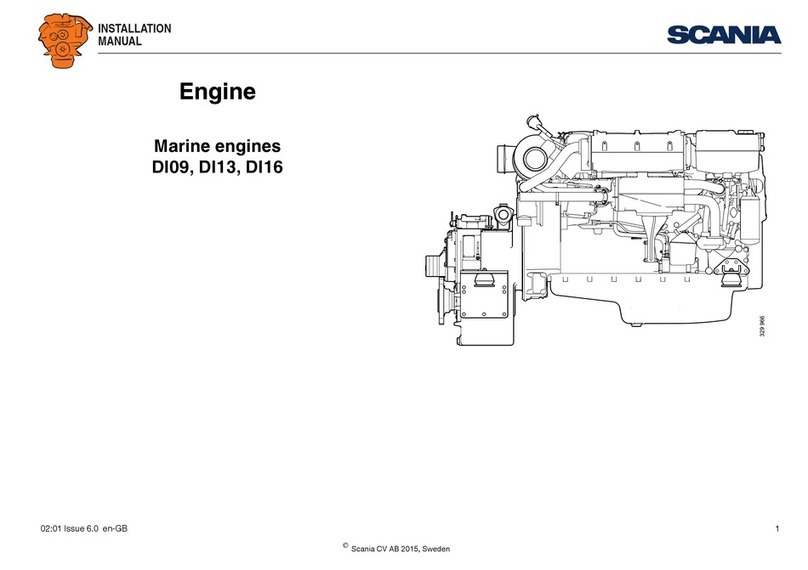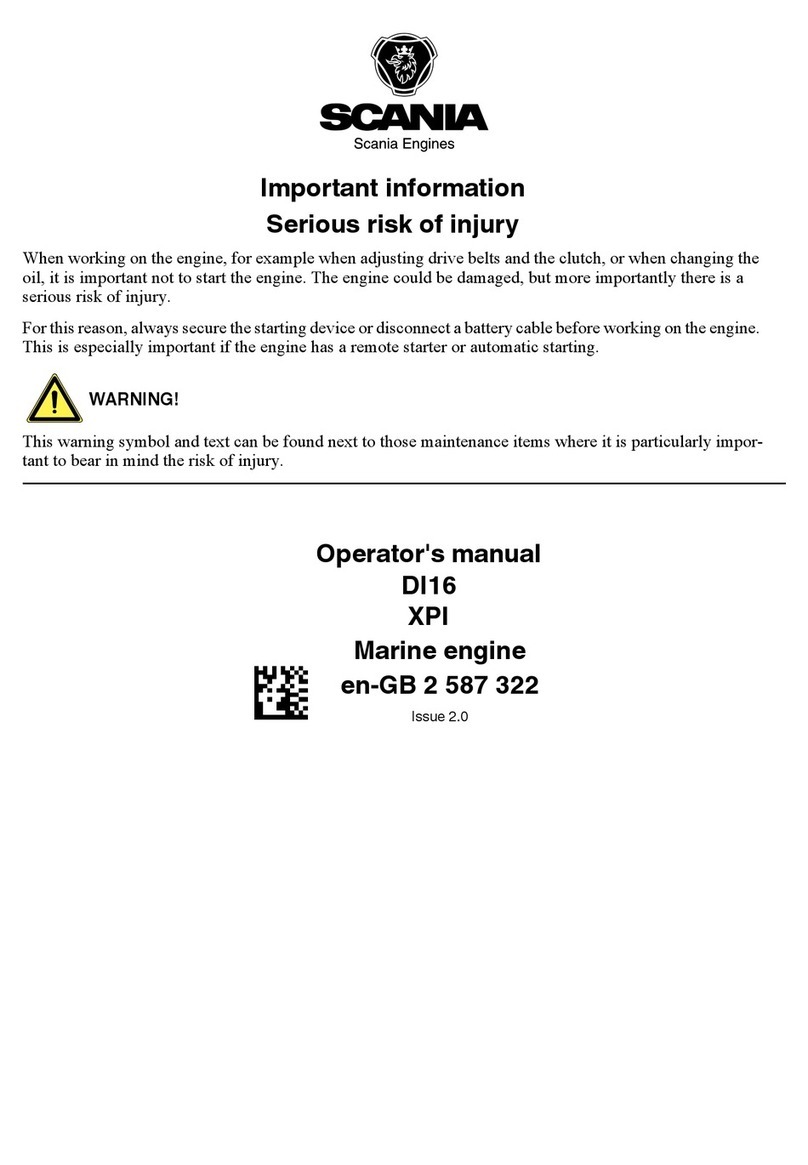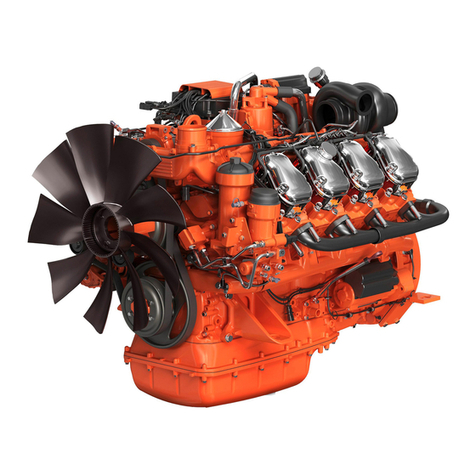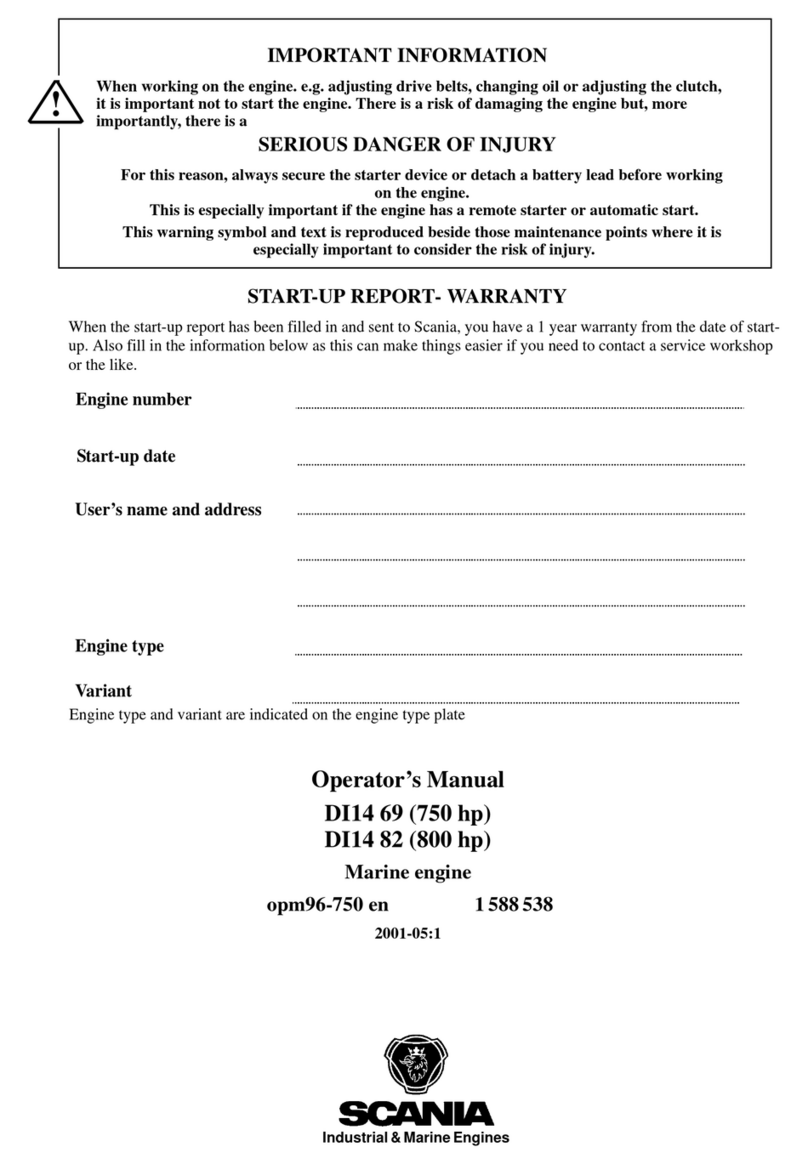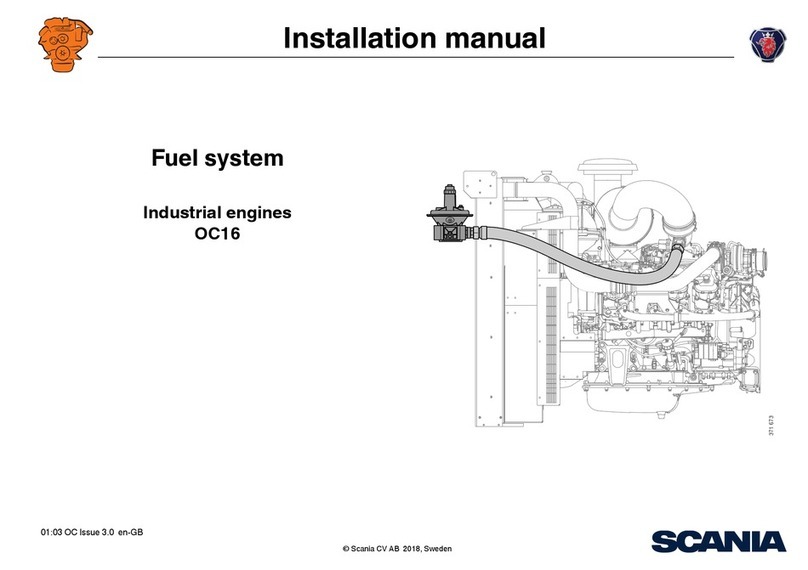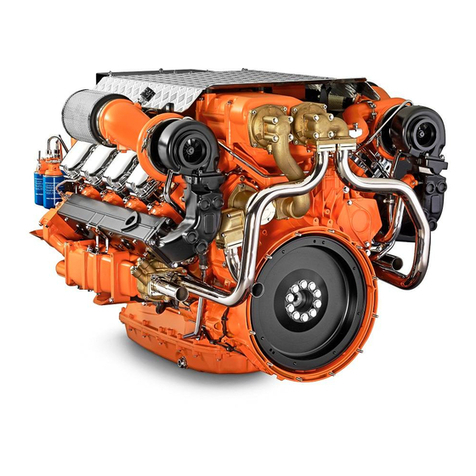
2001-05:1 © Scania Industrial & Marine Engines 3
CONTENTS
FOREWORD . . . . . . . . . . . . . . . . . . . . . . . . . . 2
CONTENTS . . . . . . . . . . . . . . . . . . . . . . . . . . . 3
ENVIRONMENTAL RESPONSIBILITY . . . . . .4
CERTIFIED ENGINES . . . . . . . . . . . . . . . . . . . .5
SAFETY DETAILS . . . . . . . . . . . . . . . . . . . . . . .6
Safety precautions for operation . . . . . . . . . . . .7
Safety precautions for handling materials . . . . .8
Safety precautions for care and maintenance . .8
TYPE DESIGNATIONS . . . . . . . . . . . . . . . 10
DEC2 CONTROL SYSTEM . . . . . . . . . . . . 12
STARTING AND RUNNING . . . . . . . . . . . 18
AT FIRST START . . . . . . . . . . . . . . . . . . . . . . .18
CHECKS BEFORE RUNNING . . . . . . . . . . . . .19
STARTING THE ENGINE . . . . . . . . . . . . . . . .19
At temperatures below 0 °C: . . . . . . . . . . . . . .20
RUNNING . . . . . . . . . . . . . . . . . . . . . . . . . . . . .21
Engine speed . . . . . . . . . . . . . . . . . . . . . . . . . .21
Coolant temperature . . . . . . . . . . . . . . . . . . . .21
Oil pressure . . . . . . . . . . . . . . . . . . . . . . . . . . .22
STOPPING THE ENGINE . . . . . . . . . . . . . . . . .22
Clutch . . . . . . . . . . . . . . . . . . . . . . . . . . . . . . .23
CHECKS AFTER RUNNING . . . . . . . . . . . . . .23
MAINTENANCE . . . . . . . . . . . . . . . . . . . . . 24
ENGINES WITH FEW HOURS
OF OPERATION . . . . . . . . . . . . . . . . . . . . . . . .24
MAINTENANCE SCHEDULE . . . . . . . . . . . . .25
LUBRICATING OIL SYSTEM . . . . . . . . . 26
OIL GRADE . . . . . . . . . . . . . . . . . . . . . . . . . . . .26
Oil analysis . . . . . . . . . . . . . . . . . . . . . . . . . . .26
CHECKING THE OIL LEVEL . . . . . . . . . . . . .27
OIL CHANGE . . . . . . . . . . . . . . . . . . . . . . . . . .27
Maximum angles of inclination during
operation . . . . . . . . . . . . . . . . . . . . . . . . . . . . .27
CLEANING THE OIL CLEANER . . . . . . . . . .28
CHANGING THE OIL FILTER . . . . . . . . . . . .30
COOLING SYSTEM . . . . . . . . . . . . . . . . . . 30
CHECKING COOLANT LEVEL . . . . . . . . . . .30
CHECKING CORROSION BARS . . . . . . . . . . .31
CHECKING THE SEA WATER PUMP
IMPELLER . . . . . . . . . . . . . . . . . . . . . . . . . . . . .31
CHECKING THE COOLANT . . . . . . . . . . . . . .32
Changing the coolant . . . . . . . . . . . . . . . . . . .34
CLEANING THE COOLING SYSTEM . . . . . .35
Internal cleaning . . . . . . . . . . . . . . . . . . . . . . .37
AIR CLEANER . . . . . . . . . . . . . . . . . . . . . . . 38
READING THE VACUUM INDICATOR . . . .38
CLEANING THE AIR CLEANER
COARSE CLEANER . . . . . . . . . . . . . . . . . . . . .38
CLEANING OR CHANGING THE
FILTER ELEMENT . . . . . . . . . . . . . . . . . . . . . .38
CHANGING SAFETY CARTRIDGE . . . . . . . .40
FUEL SYSTEM . . . . . . . . . . . . . . . . . . . . . . . 41
CHECKING FUEL LEVEL . . . . . . . . . . . . . . . .41
CHANGING THE FUEL FILTER . . . . . . . . . . .41
CHECKING INJECTORS . . . . . . . . . . . . . . . . .42
ELECTRICAL SYSTEM . . . . . . . . . . . . . . . 43
CHECKING THE
ELECTROLYTE LEVEL IN BATTERIES . . . .43
CHECKING THE STATE OF CHARGE
IN BATTERIES . . . . . . . . . . . . . . . . . . . . . . . . .43
CLEANING BATTERIES . . . . . . . . . . . . . . . . .43
CHECKING THE COOLANT LEVEL
MONITOR . . . . . . . . . . . . . . . . . . . . . . . . . . . . .44
CHECKING THE
TEMPERATURE MONITOR . . . . . . . . . . . . . .45
CHECKING THE TEMPERATURE SENSOR .45
CHECKING THE OIL PRESSURE SEN-
SOR/MONITOR . . . . . . . . . . . . . . . . . . . . . . . . .46
CHECKING THE OIL PRESSURE MONITOR
FOR DEC 2 . . . . . . . . . . . . . . . . . . . . . . . . . . . . .46
CHANGING THE BATTERY . . . . . . . . . . 47
MISCELLANEOUS . . . . . . . . . . . . . . . . . . . 47
CHECKING THE DRIVE BELT . . . . . . . . . . . .47
CHECKING FOR LEAKAGE, RECTIFY
AS NECESSARY . . . . . . . . . . . . . . . . . . . . . . . .48
CHECKING/ADJUSTING VALVE
CLEARANCE . . . . . . . . . . . . . . . . . . . . . . . . . . .49
CHANGING (OR CLEANING) THE CLOSED
CRANKCASE VENTILATION VALVE . . . . .50
LONG-TERM STORAGE . . . . . . . . . . . . . . 51
Preservative fuel . . . . . . . . . . . . . . . . . . . . . . .51
Preservative oil . . . . . . . . . . . . . . . . . . . . . . . .52
Preparations for storage . . . . . . . . . . . . . . . . .52
Batteries . . . . . . . . . . . . . . . . . . . . . . . . . . . . .53
Storage . . . . . . . . . . . . . . . . . . . . . . . . . . . . . .53
Taking out of storage . . . . . . . . . . . . . . . . . . .53
TECHNICAL DATA . . . . . . . . . . . . . . . . . . 54
FUEL . . . . . . . . . . . . . . . . . . . . . . . . . . . . . . 56
ALPHABETIC INDEX . . . . . . . . . . . . . . . . 58
https://www.boat-manuals.com/scania/
